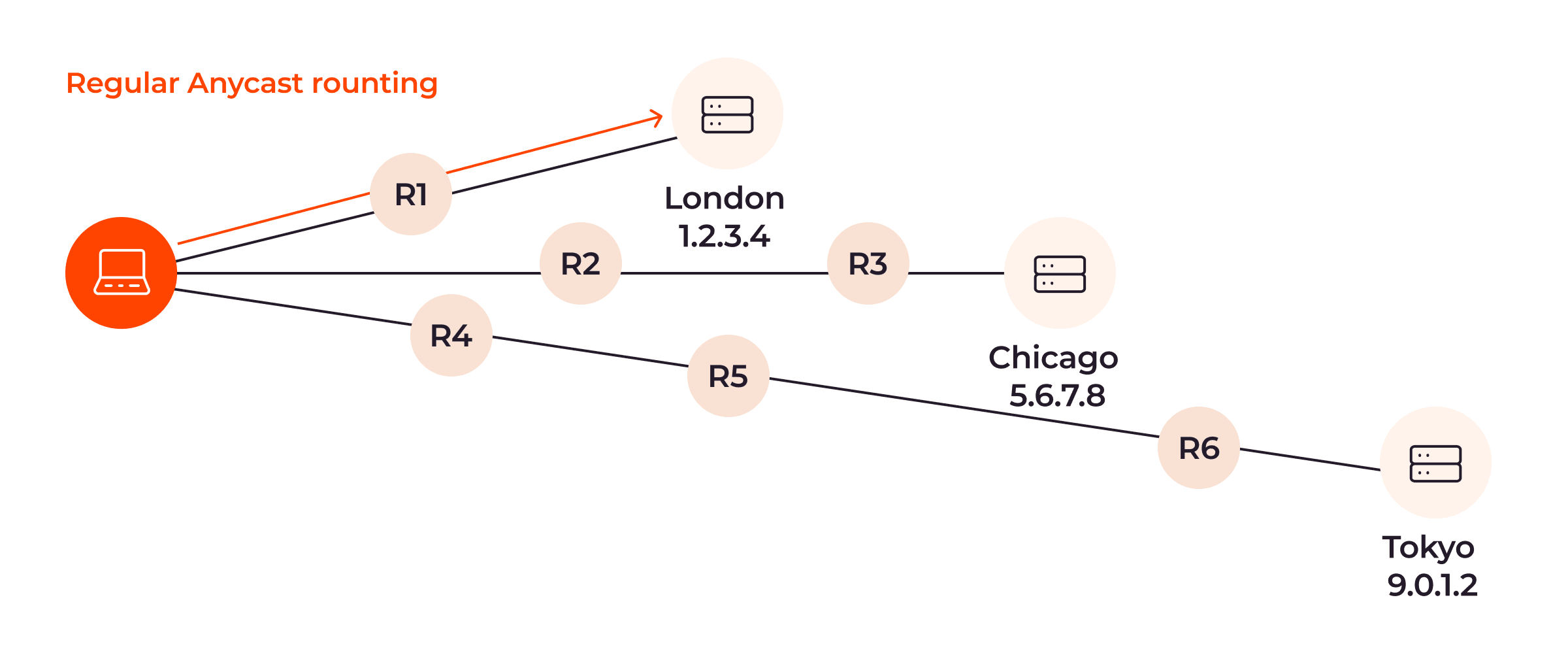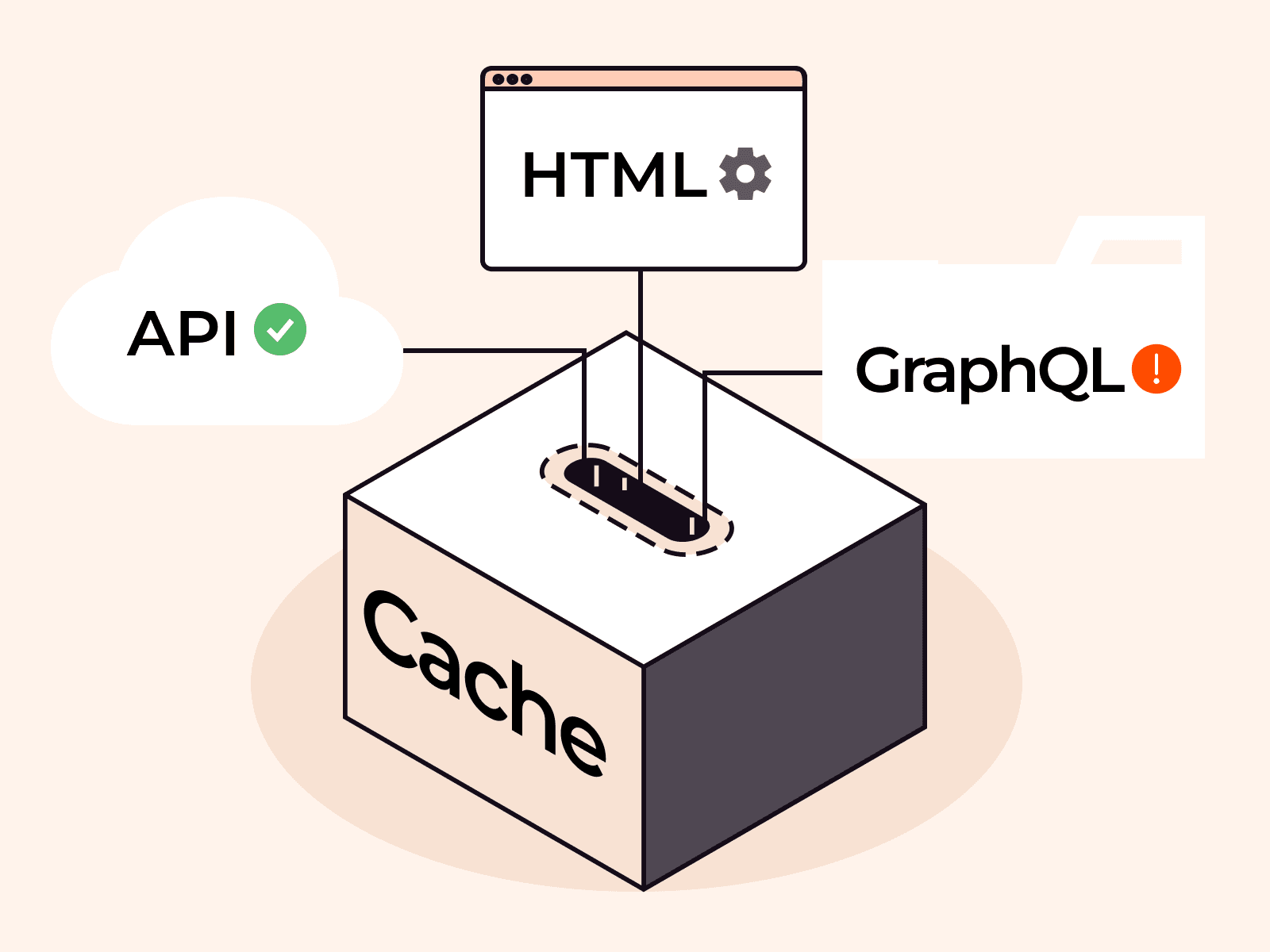Anycast is a network addressing method where multiple servers share the same IP address and are located in different global locations. When you make a request, like loading a webpage, the Anycast system routes your request to the nearest server, making the process faster and more reliable than the alternative system—Unicast. In this article, we’ll take a comprehensive look at Anycast, including what it is, why it matters, use cases, and challenges.
What Is Anycast?
Anycast is a network technique that optimizes packet delivery by directing them to any server within a group of servers, a network. Anycast routes responses to requests through the closest available server. If one server is unavailable, the request automatically finds its way to the next closest operational server. Think of how a car’s GPS reroutes you in case of a road closure—you might not even notice it happens, and you still arrive at your destination quickly and smoothly since the GPS can assess the available routes and take the best one each time.

As the image above shows, all servers share the same IP address, and the server nearest to the request source takes charge of routing the packet to the client; that is, the server used is the one with the fewest hops. Hops are the total number of routers that a packet passes through from the server to the end user. This Anycast approach reduces latency and ensures redundancy, making it a valuable asset in network optimization.
Differences Between Anycast and Unicast
Unicast is the alternative to Anycast. Anycast and Unicast routing methods both involve the transmission of packets from a single source to a designated destination. However, their core distinction lies in how they handle the assignment of IP addresses:
- Unicast strictly associates a single IP address with one server, so that each IP corresponds to a unique server. No matter where in the world the end user is, only one server routes content to the end user.
- Anycast assigns a single IP address that is mapped to multiple servers. Since multiple servers share the same IP address, data packets can be directed to the nearest or optimal server within the Anycast group.

Comparing Unicast and Anycast
| Parameter | Unicast | Anycast |
| Number of hops | Hops may be higher because packets are routed to the same geolocation irrespective of the distance between the client and the origin server. | Equal or lower to Unicast number of hops, because BGP routing to access the server with the fewest hops required. |
| Performance | User experience differs across locations; the farther a user is from the server, the slower the performance. | Equally high performance regardless of location. |
| Reliability | There are no servers available for traffic rerouting during overload or downtimes, resulting in unreliability at peak times or in cases of server outage. | In the case of an outage, users are rerouted to alternative servers. |
How Does Anycast Work?
Anycast works by leveraging Border Gateway Protocol (BGP) to announce the same IP address from multiple geographically dispersed locations. When a user sends a request to that IP address, BGP routes it to the nearest server in the Anycast group based on the distance and policies pre-configured by the administrator.
If a server becomes unreachable—perhaps due to a cyberattack or power outage—BGP automatically directs incoming traffic to the next closest and operational server, ensuring high availability and reduced latency.
For example, in figure 3, R1 is the optimal route to a server in London, so in a normal situation R1 will be used. But if the London server goes off-grid per figure 4, BGP will route all client requests via R2 and R3 to and from a server in Chicago (if the Chicago server is available and next closest to the client.)


What Is Border Gateway Protocol (BGP)?
BGP is the core protocol for internet networks to exchange routing information, and is used by Anycast to perform its functions. To understand Anycast fully, we need to first understand BGP.
BGP operates via a routing table, which functions as a comprehensive catalog, containing IP addresses and autonomous system numbers (ASNs.) ASNs are unique identifiers assigned to a network or a group of networks, each managed by a single routing policy and administrator.
How Does Anycast Use BGP?
Anycast leverages the information stored in the BGP routing table to make smart routing decisions. The BGP routing table shows the best routes from all available options. BGP determines which server is the closest in terms of network distance (topological distance within BGP) by referring to the routing table’s data. This selection ensures that packets are directed to the server that offers the shortest route, optimizing efficiency and reducing latency in the process.

Anycast’s effectiveness lies in its ability to make intelligent routing decisions, which result in swifter and more efficient data delivery. This process can be broken down into four key steps:
- Shared IP announcement: Multiple servers announce that they share the same IP address, broadcasting their availability.
- BGP routing: BGP announces IP routes to these servers, which serve as the roadmap for determining the most efficient path to reach these servers.
- Request routing: When a user sends a request, BGP takes charge of directing the response to the nearest server. It considers various factors, such as the number of hops and network settings, to make this decision, ensuring the fastest route.
- Failover mechanism: If a server becomes unavailable or experiences a failure, BGP removes it from the routing table to prevent further announcements. Once the server is back online, BGP automatically reroutes packets to the next available server. This proactive failover mechanism ensures uninterrupted service and minimizes disruptions in data delivery.
Benefits of Anycast
Anycast plays a pivotal role in optimizing various aspects of network operations.
Improved Performance
Anycast can dramatically enhance application performance and availability. By deploying multiple servers with the same IP address across diverse locations, Anycast ensures swift content delivery to end users, regardless of their geographical location. This eliminates the frustrating delays often associated with long-distance data transmission, leading to improved user experiences and higher conversion rates globally.
Availability and Redundancy
Anycast is a robust redundancy mechanism. In scenarios where servers become unavailable due to factors like maintenance, damage, or upgrades, Anycast ensures that clients can still receive requested packets. If one server goes offline, BGP dynamically reroutes traffic to the next closest available server. This results in minimal disruptions, with only a slight increase in latency experienced by the end user, as opposed to downtime without Anycast.
Load Balancing
Anycast is a valuable tool for load balancing, particularly in high-traffic networks. It evenly distributes incoming traffic among several operational servers, preventing the overburdening of any single server. This proactive traffic management minimizes the risk of server failures and high latency, ensuring consistent service quality.
Scalability
As organizations grow and expand, traffic management can become challenging. Anycast offers a simple solution to companies needing to scale by allowing the seamless addition of servers to the existing network. When traffic spikes occur in established locations or when a business expands into new geographic markets, new servers can be integrated into the Anycast group effortlessly and without disruption.
DDoS Protection
Distributed Denial of Service (DDoS) attacks are a significant cybersecurity threat whereby cybercriminals overwhelm a server with excessive traffic with the aim of rendering the server unavailable. With Anycast, if cybercriminals succeed in overwhelming the server(s), BGP can swiftly reroute packets to an alternative, available server.
While Anycast can serve effectively as an initial line of defense against DDoS attacks, it is not a foolproof protection mechanism. Preventing DDoS attacks requires more than rerouting because cyber criminals can choose to attack endpoints and networks instead of servers, at which point the attack will be successful. For comprehensive DDoS defense, it’s best to employ a specialized DDoS protection provider such as Gcore, equipped with the expertise and infrastructure necessary to mitigate DDoS attacks.
What Are The Challenges of Implementing Anycast?
Despite its numerous advantages, Anycast does also have limitations.
Configuring Anycast
Proper configuration of Anycast is essential to harness its full potential. Incorrect setup—perhaps by misconfiguring the routing settings on the servers—can lead to suboptimal routing and service disruptions. Therefore, meticulous planning and management are crucial to ensuring a seamless Anycast implementation that maximizes network performance and reliability.
Operational Complexity
Efficiently implementing Anycast requires considerable expertise: Setup and ongoing maintenance of this intricate infrastructure requires skilled technicians.
Security
At the core of Anycast’s architecture is BGP. BGP’s routing of packets is susceptible to interception by intermediate routers, potentially resulting in Man-in-the-Middle (MITM) attacks.
Who Uses Anycast?
Two major services use Anycast: CDN (content delivery network) providers and DNS (Domain Name System) providers.
- CDN providers: CDN providers leverage Anycast as part of their goal of optimizing the delivery of content over the internet. They strategically position edge servers around the world so that end users get internet content fast, enhancing user experience. HTTP requests from users are directed to the nearest available edge server using Anycast. In the event of a server outage in one location, Anycast seamlessly reroutes traffic to the next operational edge server, maintaining uninterrupted service.
- DNS providers: Anycast plays a crucial role in enhancing the resilience and performance of DNS infrastructure. DNS is responsible for translating human-readable domain names into IP addresses, facilitating internet communication. DNS providers deploy Anycast to maintain multiple geographically distributed instances of a single nameserver. This approach ensures redundancy and high availability. If one instance becomes unavailable, Anycast, coupled with BGP’s dynamic routing capabilities, removes it from the routing table and automatically redirects DNS queries to the next available instance, minimizing disruptions in DNS resolution.
To enjoy the benefits of Anycast explained earlier, opt for a CDN/DNS provider that offers Anycast, such as Gcore. CDN/DNS providers that use Anycast usually state this in public materials. You can also double-check their service-level agreement (SLA) to verify.
Conclusion
Anycast offers incredible benefits, but setting up your own Anycast infrastructure can be complex and costly. That’s where a reliable DNS Anycast provider like Gcore comes in. With an average worldwide latency of just 20ms (12ms in Europe) and 150+ points of presence, Gcore is a leading DNS Anycast provider.
Gcore’s CDN also harnesses the power of Anycast, and soon you’ll be able to enable Anycast settings on global servers (Global Anycast.) As you keep your eyes peeled for updates, you can also get started with Gcore for free right now!
Related articles
Subscribe to our newsletter
Get the latest industry trends, exclusive insights, and Gcore updates delivered straight to your inbox.






